Review of Otogi Zoshi: Vol. 1 Legend Of The Magatama
Introduction
This one slipped in under my radar. Manga Entertainment is in the middle of a resurgent period both worldwide and in the UK, in part on the back of the success of the Ghost In The Shell Franchise. This year has seen the release of shows like Saikano a.k.a. She, The Ultimate Weapon, Heat Guy J and Tetsujin 28 with great fanfare. We will also see Naruto make its UK DVD debut in August. I can be forgiven for not knowing about this series until the first volume turned up for review.
Otogi Zoshi is a 26 episode series that has an interesting premise. It`s a story told over a thousand years, with the final half set in the present day, while the first thirteen episodes are set back in the Heian period of Japanese history (Don`t worry if the history eludes you, as this is one anime disc with copious and relevant extra features). Coming from the powerhouse that is Studio I.G. the company behind Ghost In The Shell Stand Alone Complex, this is a tantalising title. The story begins in a dark period of Japan`s history, the country is afflicted by disease and famine, and the cities and countryside may as well be separate states, torn apart by inter-clan feuds. There is hope though, in a magical artefact called the Magatama, whose power can heal the country and salve the woes of the people. The trouble is that it is in the possession of the Tsuchigomo clan, and it is by an Imperial decree that the Minamoto clan is responsible for its safe retrieval. It`s just that the lord is deathly ill, and his young sister must disguise herself as a man and take on his mission. Volume 1 contains the first five episodes.
1. Raiko
Minamoto no Hikaru, is masquerading as the Lord Raiko in order to fulfil her family`s duty to retrieve the Magatama. She travels with her bodyguard Watanabe no Tsuna, but the journey through the forest is dangerous, and the Tsuchigomo clan are hunting the two visitors from the capital.
2. Sadamitsu
Hikaru and her bodyguard need to rest and heal from their wounds, so they head for a local village. Despite a rather rude reception from the village lout Sadamitsu, the townsfolk welcome them. Oddly, this village is untroubled by the Tsuchigomo, and it becomes clear as to why when they are attacked while sleeping. The trail leads right back to Sadamitsu.
3. Tsuchigomo
The travellers head into the Tsuchigomo subterranean hideout. The Magatama bead is heavily guarded, and retrieving it will require a sacrifice. But there is more at stake here than just one item of treasure, lies must be uncovered and the true villain of the plot remains to be unmasked. Even if Hikaru can get the Magatama, she still has a race against time to return to the city.
4. Rashomon
Hikaru is ordered to attend an audience with the Emperor, but demurs. There is a rumour of a demon haunting the Rashomon, and in her melancholy, Hikaru walks straight into the confusion. When she does finally attend the palace, once again disguised as her brother, she learns that her family`s responsibility hasn`t yet been discharged.
5. Urabe
Hikaru and her party set out once more in search of another Magatama bead, this time located on the Cursed Island in Saigoku. The Imperial Court has assigned help to the mission, an enigmatic woman named Urabe, and her help seems invaluable when they come to a village from where they must get passage to the island. Yet the ease with which they progress is suspicious, and it seems Urabe knows too much.
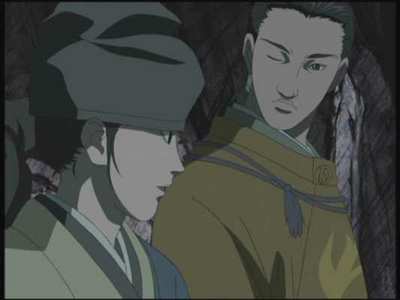
Video
In the US, an hour of extra features, as well as two hours of episodes were released as a two disc set. In the UK, Manga Entertainment take the same material, add a couple of half bitrate DTS soundtracks as well as their usual abundance of trailers to boot, and cram it all onto one disc. You would expect something to give in terms of the visuals, and you would be right to. It`s just that it`s nowhere near as bad as I expected. In fact, the really severe pixellation and artefacting is confined to the Manga Attacks trailer reel.
Otogi Zoshi is presented in a 4:3 aspect ratio, and the transfer for the most part is clear, sharp and colourful. Indeed the crispness of the image and the fluidity of the animation give the distinct impression that this is not one of the usual NTSC-PAL conversions. That said, there is the usual colour banding associated with anime transfers, and fast action scenes do throw up some compression artefacts. It`s only when I paused the image to take a closer look that I noticed the artefacts around fine detail. In normal play these are imperceptible, and it`s only because I was looking for them that I noticed them. I watched the episodes through with nothing to hinder my enjoyment, but I would guess that watching the show on a screen much larger than say 32 inches would be a different matter.
The animation, as you would expect from Production I.G is something quite special. The show opens with a rather splendid shadow play before the credits, black silhouettes against a blood red background, before starting the show proper. The animation is very stylised, the character designs are minimalistic, but never to the detriment of the animation, and the look is something akin to an animated painting. It`s all very effective.
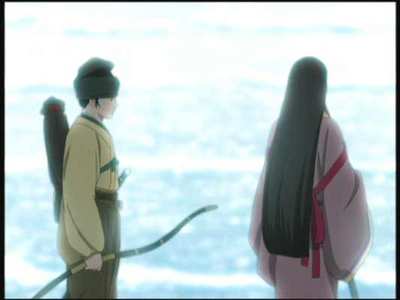
Audio
You can choose between DD 2.0, DD 5.1 and DTS soundtracks in both English and Japanese, with optional translated English subtitles in a nice white on black font. I chose the Japanese 5.1 track and after an initial hiccup, with a rather hollow sounding theme tune, it settled down into a fairly decent surround track, with perhaps a slightly aggressive use of the rears. The English surround track is a tad more subdued by comparison, and as usual with recent anime releases, the dub is professional and easy to listen to. The opening theme takes a little getting used to, but the closing theme is another excellent piece of music to accompany a Japanese animation.
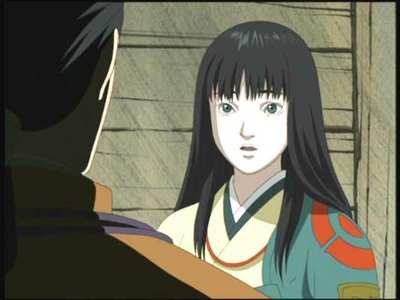
Features
This disc comes with animated menus and a play all option. If you choose the latter you`ll only have to face the logos once, but choose the episodes separately and you`ll have to sit through 11 extra seconds of CGI before each episode.
Manga put the usual trailers on this disc, but there are just five of them, as opposed to the cornucopia you get with their other releases, the Manga Attacks, Art Of Anime, Ghost In The Shell: SAC, Innocence and Heat Guy J. You also get the textless opening and closing sequences that usually accompany anime releases.
More substantial are the Group Discussion segments. There are two of these and last 25 and 23 minutes respectively. In them, Director Mizuho Nishikubo, Character Designer Shou Tajima, Animation Director Kazuchika Kise, and Episode Director/Screenplay Yoshiki Sakurai gather for an informal chat at a bar. They discuss everything from the animation to researching the period, the structure of the story and the characters. There is plenty of info to be gleaned here, and it is all subtitled for viewer convenience. There are also one or two spoilers for later in the series.
Finally there is a Tokyo University Heian Lecture that is made up of two segments lasting a total of 23 minutes. Dr Kazato Hongo, Professor of History at Tokyo University acted as historical consultant on the show, and he uses this opportunity to talk a little about the Heian period. This is with reference to how accurate the show is to what is known and he examines each episode one by one, pointing out items of historical significance, and where dramatic licence was taken.
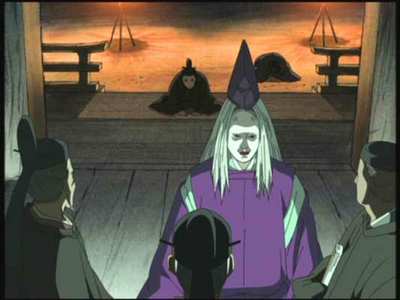
Conclusion
Most shows and movies about Japanese history that I have seen concentrate on the Warring States or the Edo periods. This look into the Heian period offers something new, an insight into a different time and place. You could liken it to the apparent dearth of films and TV shows set in Britain`s Dark Ages. But while Otogi Zoshi can be considered a significant achievement simply for offering something different, it still succeeds or fails on the strength of the underlying story, and for me the coin is still up in the air on that one.
The main story is a little mundane, with travellers once again on a quest to find a treasure that will save the nation. It`s a staple genre that isn`t expanded or presented in a new way here. The period setting, and Hikaru travelling through Japan with her bodyguard reminded me a little of Samurai Champloo, only without the wit and irreverence. Otogi Zoshi is a little too staid and formal, and what little humour there is really only comes when the character of Sadamitsu is introduced. The Heian arc was initially supposed to last 26 episodes, but for reasons of pacing and tension was shortened to 13. Yet the pace of the episodes is sedate, and the main story develops slowly. Five episodes in and main characters are still being introduced. Fortunately there is a good deal going on in the background. Seeing Japanese society of 1000 years ago is interesting, the country is in a state of turmoil and decay. This show sees the Emperor somewhat beleaguered in his capital, his advisers and courtiers plotting against him, against each other and hatching various plots and schemes. In this, the religious figure of Abe no Seimei pulls strings and influences the powerful, who all treat the philosophy of Yin and Yang as gospel. Through this all flits the enigmatic figure of Mansairaku, court dancer who obviously has some major purpose in the story, but one which is yet to be revealed.
Manga Entertainment can be a tad confusing. They have an admirable ethos of providing value for money, and the majority of their releases boast the full selection of soundtrack options. Usually that means that they release 2-disc sets, with shows like Heat Guy J and Robotech needing the extra space for a higher episode count. Then there are flagship titles like Ghost In The Shell: Stand Alone Complex and Saikano, which split the soundtracks across two discs to ensure the best possible audiovisual transfer. It`s the ones where everything is crammed onto one disc that gives me pause for thought. Last month`s Volume 1 of Tetsujin 28 is a case in point, five episodes and six soundtracks all on one disc, and the visuals suffered from digital artefacts as a consequence. Otogi Zoshi`s first volume has even more, five episodes, six soundtracks as well as over an hour of extra features. Almost three and a half hours of video on one disc is pushing the envelope, and surely this should have been a two-disc edition. Still, the video was never less than watchable, although I do have concerns about how it will look on larger screens.
Otogi Zoshi looks impressive; it has a singular style that renders it unique in my experience. The simplified characters, muted palette and period setting, coupled with the striking animation are a major attraction. That has to be balanced with a story that is fairly run of the mill, characters which fall neatly into familiar stereotypes and a narrative that is mundane and lacks innovation. Yet it is early days, and the story has yet to unfold. The pace is slow, but the background to the story is rich and interesting, and the machinations of the Imperial Court and the enigmatic characters like Abe no Seimei and Mansairaku offer interest where the main characters fail to. What is the hook for me is the prospect of how the story will develop thirteen episodes in. I`m intrigued as to just how the story will translate to the present day, and how the look of the anime will alter without losing its unique essence. Otogi Zoshi looks to be a slow burner, and a show that will be easier to judge a few volumes down the line. As of right now, I`d recommend it solely for the period setting and distinctive style.
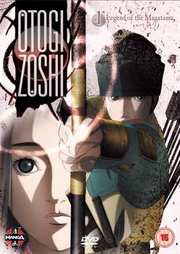




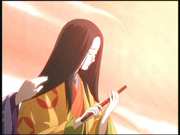

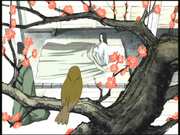
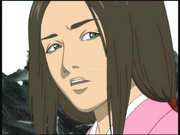
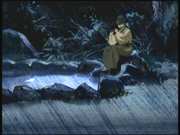
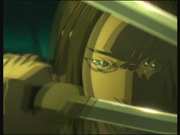
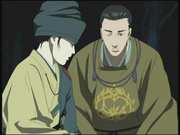

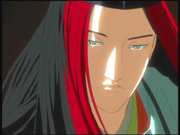

































Your Opinions and Comments
Be the first to post a comment!